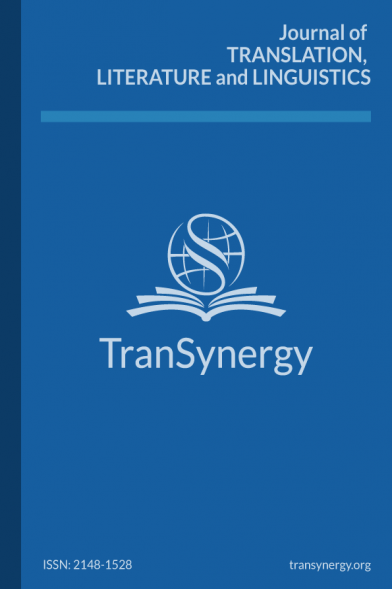The Impact of Discourse Markers on Conversational Coherence
discourse, discourse markers, conversational coherence, spoken discourse, utterance meaning
The Impact of Discourse Markers on Conversational Coherence
discourse, discourse markers, conversational coherence, spoken discourse, utterance meaning,
___
Alonso-Almeida, F., and Álvarez-Gil, F., J. (2021). The Discourse Markers Indeed, in fact, really and actually and Their Spanish Equivalents in Economy. Revista de Lingüística y Lenguas Aplicadas, Vol. 16, pp. 11-23.
Andersen, G. (1998). The pragmatic marker like from a relevance-theoretic perspective. In A. H. Jucker and Y. Ziv (Eds.), Discourse Markers: Description and Theory (pp. 147–170). John Benjamins.
Ang, Z. (2014). The Effects of Discourse Markers on the Reading Comprehension and Speed of Chinese Learners of English. International Journal of English Language and Linguistics Studies Vol.2, No.2, pp. 27-49.
Aysu, S. (2017). The Use of Discourse Markers in the Writings of Turkish Students of English as a Foreign Language: A Corpus Based Study. Journal of Higher Education and Science. Vol. 7, Number 1, pp. 132-138.
Bartolo Jr., E., S. (2019). “Well… Y’know… Okay…” An Analysis of Discourse Markers’ Pragmatic Functions and Sentence Positions among Senior High School English Teachers’ Spoken Discourse: Implications for Language Teaching, International Peer Reviewed Journal, Vol. 3, pp. 1-30.
Blakemore, D. (2002). Relevance and Linguistic Meaning. The semantics and pragmatics of discourse markers. Cambridge, Cambridge University Press
Blakemore, D., L. (1987). Semantic constraints on relevance. Oxford: Blackwell.
Brinton, L. (1996). Pragmatic markers in English: grammaticalization and discourse functions. Topics in English Linguistics. Mouton de Gruyter.
Castro, C., M., C. (2009). The Use and Functions of Discourse Markers in EFL Classroom Interaction. PROFILE 11, Bogotá, Colombia, pp. 57-77.
Fraser, B. (1993). Discourse Markers Across Language. Pragmatics and Language Learning Monograph Series, Vol. 4.
Fraser, B. (1996). Pragmatic Markers. Pragmatics, vol. 6, no. 1, pp. 167–190.
Gee, J., P. (1999). An Introduction to Discourse Analysis. Theory and Method. Routledge.
Hansen, M., M. (1998). The semantic status of discourse markers. Lingua 104, pp. 235-260.
Hasund, I. (2003). The discourse markers like in English and liksom in Norwegian teenage language: a corpus-based, cross-linguistic study. [Doctoral dissertation, Department of English], University of Bergen.
Jucker, A., H. and Smith, S., W. (1998). And people just you know like ‘wow’: Discourse markers as negotiating strategies. In A. H. Jucker and Y. Ziv (Eds.), Discourse Markers: Description and Theory (pp. 171–202). John Benjamins.
Kamali, F., and Noori, H. (2015). The impact of discourse markers instruction on improving writing of intermediate EFL learners. Cumhuriyet Üniversitesi Fen Fakültesi Fen Bilimleri Dergisi (CFD), Cilt:36, No: 3 Özel Sayı.
Lakoff, R. (1975). Language and Woman’s Place. NewYork: Harper Colophon
Müller, S. (2005). Discourse Markers in Native and Non-native English Discourse. John Benjamins Publishing Company.
Östman, J. (1981). You know: A Discourse-Functional Approach [Vol. II:7: Pragmatics & Beyond]. John Benjamins
Redeker, G. (1990). Ideational and pragmatic markers of discourse structure. Journal of Pragmatics, Vol. 14, pp. 367–381.
Romaine, S. and Lange, D. (1991). The use of like as a marker of reported speech and thought: A case of grammaticalization in progress. American Speech, Vol. 66, pp. 227–279.
Sáez, F., T. (2003). Culture in Writing: Discourse Markers in English and Spanish Student Writing. Tadea seu liber de Amicitia, Granada, Imprenta Generalife, pp. 345-364.
Schiffrin, D. (1987). Discourse markers. Cambridge University Press.
Schiffrin, D., (2001). Discourse Markers: Language, Meaning, and Context. In D. Schiffrin, D. Tannen, and H., E. Hamilton (Eds.), The Handbook of Discourse Analysis (pp. 54-75). Blackwell Publishers.
Schourup, L., C. (1985). Common Discourse Particles in English Conversation. Routledge.
Shen, Y. (2007). An analysis of discourse markers used by non-native English learners: its implication for teaching English as a foreign language. pp. 51-83.
Sun, W. (2013). The Importance of Discourse Markers in English Learning and Teaching.
Syahabuddin, K. and Zikra, A. (2020). An Analysis of Contrastive Discourse Markers in Students’ Essays. In Proceedings of the 1st Bandung English Language Teaching International Conference (BELTIC 2018), pp. 72-77. Science and Technology Publications. Theory and Practice in Language Studies, Vol. 3, No. 11, pp. 2136-2140.
Traugott, E., C. (1995). The Role of the Development of Discourse Markers in a Theory of Grammaticalization. Paper presented at ICHL XII, Manchester.
Urgelles-Coll, M. (2010). The Syntax and Semantics of Discourse Markers. Continuum Studies in Theoretical Linguistics. Continuum International Publishing Group.
Valdmets, A. (2013). Modal particles, discourse markers, and adverbs with lt-suffix in Estonian. In L. Degand, B. Cornillie, and P. Pietrandrea (Eds.), Discourse Markers and Modal Particles Categorization and Description (pp. 107-131). John Benjamins Publishing Company.
- ISSN: 2979-9503
- Yayın Aralığı: Yılda 2 Sayı
- Başlangıç: 19.12.2022
V.S. NAIPAUL’S A HOUSE FOR MR. BISWAS: A STUDY OF LIMINALITY
From Colonial to Postcolonial: Dissemination of the English Language
Training on Simultaneous Interpreting at Undergraduate Level in Türkiye: Analysis of Resources
V. S. Naipaul’s “One Out of Many”: In the Middle of Nowhere
The Impact of Discourse Markers on Conversational Coherence
